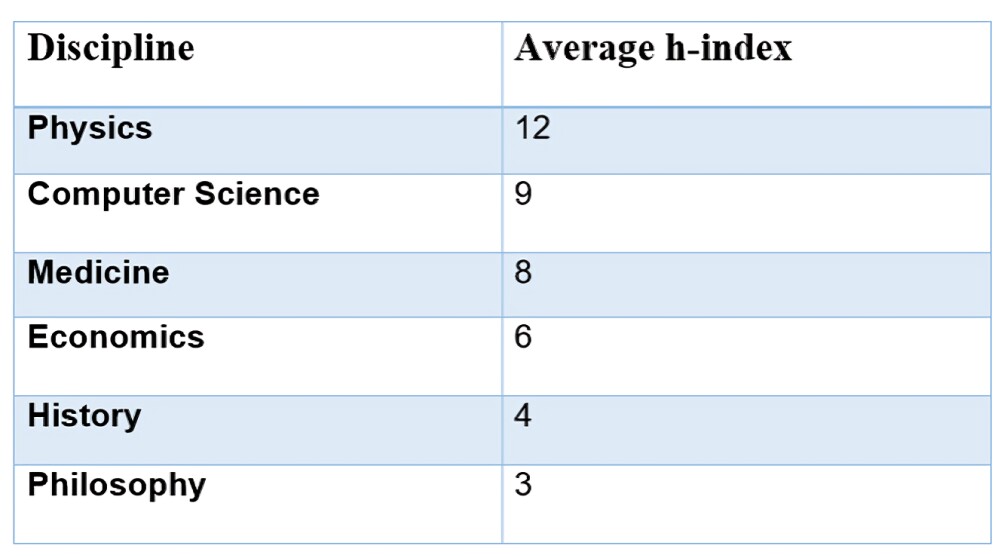مؤشر h عبر التخصصات الأکادیمیه


یتأثر مؤشر h بشکل کبیر بثقافه النشر السائده فی کل تخصص، والتی تختلف اختلافًا کبیرًا بین مجالات الدراسه المختلفه.
فعلى سبیل المثال، فی مجالات مثل الفیزیاء، والریاضیات، وعلوم الحاسوب، غالبًا ما تُکتب الأبحاث بشکل فردی، بینما فی مجالات مثل التاریخ أو الفلسفه، غالبًا ما یشارک عده مؤلفین فی إنتاج عمل واحد. وفی هذه المجالات الأخیره، قد تشیر انخفاض معدلات النشر إلى الترکیز على الجوده بدلاً من الکمیه.
تؤثر هذه الممارسات النشریه المختلفه على قیم مؤشر h، حیث إن هذا المؤشر مرتبط بشکل مباشر بعدد المنشورات.
وهذا یعنی أن الأفراد فی المجالات التی تشهد معدلات نشر مرتفعه قد یملکون مؤشر h أعلى — لیس لأن أعمالهم أکثر تأثیرًا، بل ببساطه بسبب طبیعه ثقافه النشر فی تخصصهم.

کما هو الحال فی النشر، تختلف أنماط الاستشهاد بدرجه کبیره بین التخصصات. فبعض التخصصات، مثل العلوم الطبیعیه والهندسه، تشهد معدلات استشهاد أعلى، حیث یمیل الباحثون إلى الاستشهاد بأعمال زملائهم.
فی المقابل، قد تکون تخصصات مثل العلوم الاجتماعیه والإنسانیه ذات کثافه استشهاد أقل، ربما لأن الباحثین أقل میلًا للاستشهاد بأعمال الآخرین.
یمکن أن تؤثر هذه الاختلافات على تفسیر مؤشر h، الذی یعتمد بشکل کبیر على عدد الاستشهادات التی تحصل علیها منشورات الباحث.
فقد یراکم الباحثون فی المجالات ذات الاستشهادات المرتفعه قیم h-index مرتفعه تظهر وکأنها مبالغ فیها مقارنهً بنظرائهم فی تخصصات أخرى، حتى لو کانت أعمال هؤلاء ذات أهمیه أکبر أو مکافئه.

یؤثر مستوى التعاون داخل التخصص الأکادیمی أیضًا على مؤشر h. ففی التخصصات التی تهیمن فیها الأبحاث ذات المؤلف الواحد، مثل العلوم الإنسانیه، قد یُقلل مؤشر h من تقدیر الأثر الفعلی للفرد لأنه لا یأخذ فی الاعتبار مساهمات المؤلفین المشارکین.
فی المقابل، فی تخصصات مثل العلوم التی تنتشر فیها الأبحاث متعدده المؤلفین، قد یبالغ مؤشر h فی تقدیر مساهمه الفرد فی العمل.

کما یتضح من الجدول أعلاه، تختلف متوسطات مؤشر h بشکل کبیر بین التخصصات، مما یعکس الأنماط المختلفه فی النشر والاستشهاد والتعاون.

عند تقییم أثر البحث العلمی للباحثین، من المهم فهم مؤشر h فی سیاقه التخصصی الصحیح. إن مقارنه المؤشرات الخام مباشره بین باحثین من تخصصات مختلفه تمامًا قد یؤدی إلى استنتاجات مضلله ومنحازه.
وبدلاً من ذلک، یجب مقارنه الأفراد بنظرائهم فی نفس المجال أو مجالات قریبه، مع مراعاه ممارسات النشر والاستشهاد التی تُنتج تلک القیم فی ذلک التخصص.
علاوه على ذلک، یجب أن تُدرک المؤسسات وصناع القرار حدود مؤشر h وأن تستخدمه جنبًا إلى جنب مع مؤشرات أخرى عند تقییم الأداء البحثی.
إن أسلوب التقییم الشامل، الذی یأخذ فی الاعتبار جوده وأثر المنشورات الفردیه، والتمویل البحثی، والمؤشرات النوعیه الأخرى، یمکن أن یقدم صوره أکثر توازنًا وواقعیه لإنجازات الباحث.
من خلال الاعتراف بالاختلافات التخصصیه التی تؤثر على مؤشر h، یمکننا ضمان تقییم أکثر عدلاً ودقه للمخرجات البحثیه، مما یعزز فی نهایه المطاف المعرفه والإبداع فی جمیع المجالات الأکادیمیه.
إذا کان لدیک أی أسئله، استفسارات، أو ترغب فی معرفه المزید عن خدماتنا، فلا تتردد فی التواصل معنا. فریقنا المخصص مستعد لمساعدتک.